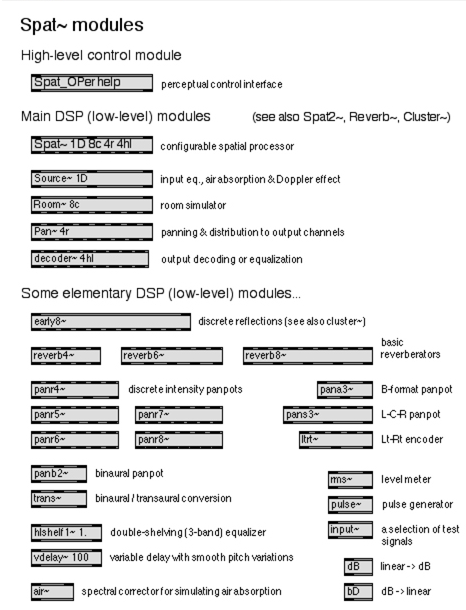Spat Reference Manual
Spat Reference Manual
|
OverviewAbout This Manual
This reference manual contains detailed descriptions of the Max objects in the Spat~ library. This information is also accessible through the standard on-line help mechanism provided in Max (the help patch pops up whenever you alt-click on the corresponding box in a patch). Some objects are not provided with a help-patch, either because their behaviour is straightforward to understand by looking inside them, or because they are too specific to be used individually. Spat~ Modules
As described in chapter 2 of the introduction manual, there are two main categories of objects in the Spat~ library: low-level objects and high-level objects.The signal processing is performed by the low-level DSP objects (e.g. Foo~), each of which is associated to a corresponding low-level control object (Foo_). Spat~ is a DSP object made of the cascade connection of four DSP objects: Source~, Room~, Pan~ and Decoder~. The control method for these modules is detailed in chapter 2 of this manual. These DSP modules take (possibly optional) arguments which allow to configure them into various implementations (for instance different loudspeaker setups for the Pan~ module). There is currently only one high-level control object, named Spat_OPer and described in chapter 4. The outlet of Spat_OPer can be connected to the rigthmost inlet of a Spat~ or Spat_ object, or to the rightmost inlet of a Room~ or Room_ object (Spat~ can be configured to be equivalent to an implementation of Room~). The characteristic property of high-level control objects is that they can translate commands and remote control messages into low-level control messages which are recognized by the DSP objects. On the contrary, low-level control objects, like Spat_ or Room_, just transmit incoming messages or actions on the user interface. The low-level DSP objects are themselves made of elementary DSP objects (whose name starts with a small letter instead of a capital letter, e.g. foo~). Each elementary DSP object is associated to a corresponding elementary low-level control object (foo_). The control method for these elementary objects is detailed in chapter 3. Unlike main low-level control objects, elementary control objects do not transmit incoming messages, but only update their graphical display accordingly. These elementary objects can be used individually, and some of them are provided with a help patch. Two of these elementary objects are described in this manual: hlshelf1~ and vdelay~. Finally, chapter 5 of this manual describes two of the miscellaneous objects used in Spat~: air~ (a spectral corrector for simulating air absorption) and input~ (an object that provides a library of test signals, used in help-patches and example patches). These DSP objects are not provided with a corresponding control object.  |
© CNAC-GP/Ircam and Espaces Nouveaux |